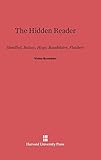The Hidden Reader : Stendhal, Balzac, Hugo, Baudelaire, Flaubert / Victor Brombert.
Material type: TextPublisher: Cambridge, MA : Harvard University Press, [2013]Copyright date: ©1988Edition: Reprint 2013Description: 1 online resource (226 p.)Content type:
TextPublisher: Cambridge, MA : Harvard University Press, [2013]Copyright date: ©1988Edition: Reprint 2013Description: 1 online resource (226 p.)Content type: - 9780674731554
- 9780674731561
- Authors and readers
- Esthétique de la réception
- Esthétique de la réception
- Französische Literatur
- Französische Literatur
- French literature
- Reader-response criticism
- Authors and readers -- France -- History -- 19th century
- French literature -- 19th century -- History and criticism
- LITERARY CRITICISM / General
- Reader-response criticism
- LITERARY CRITICISM / General
- 840/.9/007
- PQ282
- online - DeGruyter
| Item type | Current library | Call number | URL | Status | Notes | Barcode | |
|---|---|---|---|---|---|---|---|
 eBook
eBook
|
Biblioteca "Angelicum" Pont. Univ. S.Tommaso d'Aquino Nuvola online | online - DeGruyter (Browse shelf(Opens below)) | Online access | Not for loan (Accesso limitato) | Accesso per gli utenti autorizzati / Access for authorized users | (dgr)9780674731561 |
Browsing Biblioteca "Angelicum" Pont. Univ. S.Tommaso d'Aquino shelves, Shelving location: Nuvola online Close shelf browser (Hides shelf browser)

|

|

|

|

|

|

|
||
| online - DeGruyter New Travels in the United States of the America, 1788 / | online - DeGruyter The Village Entrepreneur : Change Agents in India’s Rural Development / | online - DeGruyter The Molly Maguires / | online - DeGruyter The Hidden Reader : Stendhal, Balzac, Hugo, Baudelaire, Flaubert / | online - DeGruyter Mirror on Mirror : Translation, Imitation, Parody / | online - DeGruyter Patriarch and Folk : The Emergence of Nicaragua, 1798-1858 / | online - DeGruyter On Translation / |
Frontmatter -- Acknowledgments -- Contents -- Approaches -- Opening Signals in Narrative -- Natalie, or Balzac’s Hidden Reader -- La Peau de chagrin: The Novel as Threshold -- Hugo’s William Shakespeare: The Promontory and the Infinite -- The Edifice of the Book -- V.H.: The Effaced Author or the “I” of Infinity -- Sartre, Hugo, a Grandfather -- The Will to Ecstasy: Baudelaire’s “La Chevelure” -- “Le Cygne”: The Artifact of Memory -- Lyricism and Impersonality: The Example of Baudelaire -- Erosion and Discontinuity in Flaubert’s Novembre -- From Novembre to L’Education sentimentale: Communication and the Commonplace -- Idyll and Upheaval in L’Education sentimentale -- Flaubert and the Articulations of Polyvalence -- The Temptation of the Subject -- Stendhal, Reader of Rousseau -- Vie de Henry Brulard: Irony and Continuity -- T. S. Eliot and the Romantic Heresy -- Notes -- Credits -- Index
restricted access online access with authorization star
http://purl.org/coar/access_right/c_16ec
Victor Brombert is an unrivaled interpreter of French literature; and the writers he considers in this latest book are ones with whom he has a long acqualntance. These essays--eleven of them appearing in English for the first time and some totally new--give us an acute analysis of the major figures of the nineteenth century and a splendid lesson in criticism. Brombert shows how a text works--its structure and narrative devices, and the symbolic function of characters, episodes, words--and he highlights the distinctive postures and styles of each writer. He gives us a sense of the hidden inner text as well as the techniques writers have devised to lead their readers to the discovery of what is hidden. With wonderful subtlety he unravels the reader's participatory response, whether it be Hugo reading Shakespeare, Sartre reading Hugo, Stendhal reading Rousseau, T. S. Eliot misreading Baudelaire, or Baudelaire, Balzac, and Flaubert reading their own sensibilities. This book is a sterling example of the finest kind of literary criticism--wise, intelligent, responsive, sympathetic--that reveals central aspects of the creative process and returns the reader joyfully to the texts themselves.
Mode of access: Internet via World Wide Web.
In English.
Description based on online resource; title from PDF title page (publisher's Web site, viewed 24. Aug 2021)


